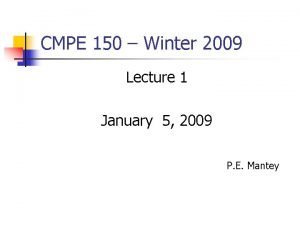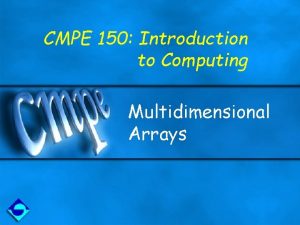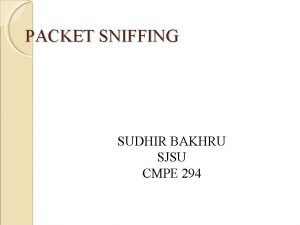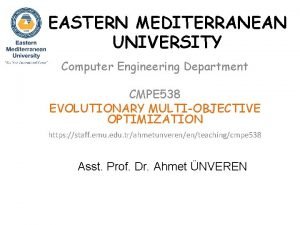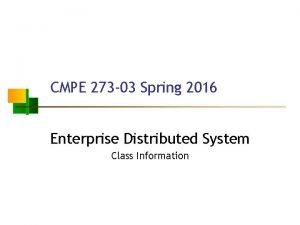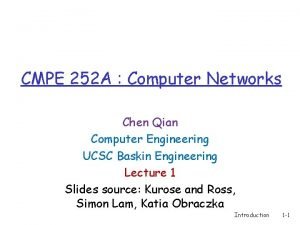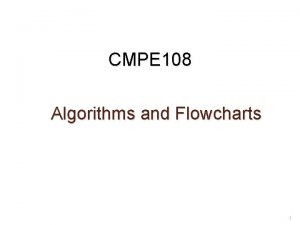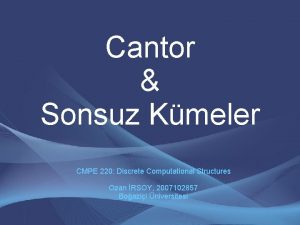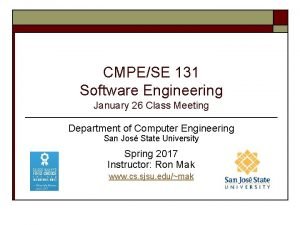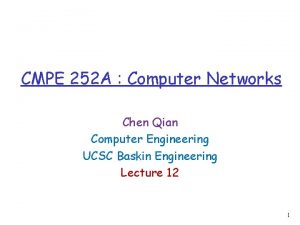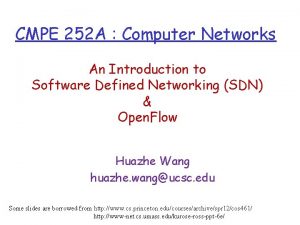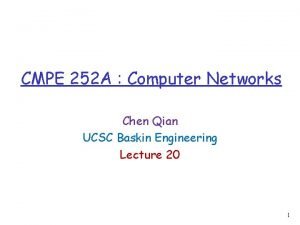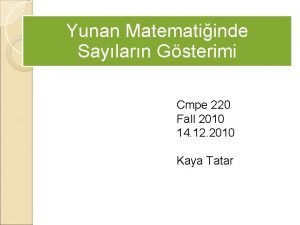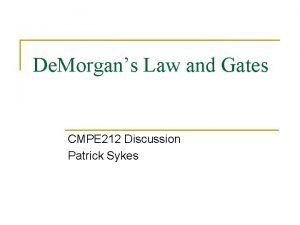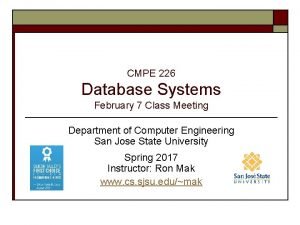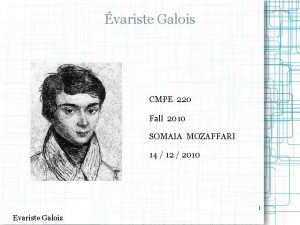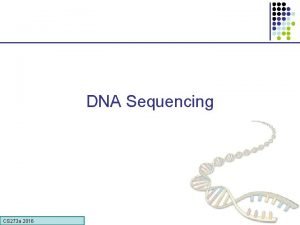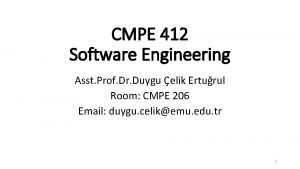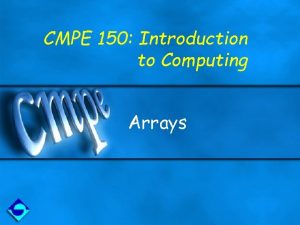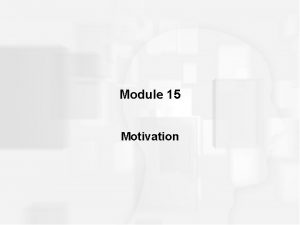CMPE 150 Introduction to Computing Structures Motivation When



![Example #1 struct stu_info { char name[41]; long int id; char dept[16]; short int Example #1 struct stu_info { char name[41]; long int id; char dept[16]; short int](https://slidetodoc.com/presentation_image_h2/bd82915eefc516ba3ff741eb7cbf7ea3/image-4.jpg)




















![Example #8 (cont'd) #include <stdio. h> struct stu_info { char name[41]; long int id; Example #8 (cont'd) #include <stdio. h> struct stu_info { char name[41]; long int id;](https://slidetodoc.com/presentation_image_h2/bd82915eefc516ba3ff741eb7cbf7ea3/image-25.jpg)





![Example #9 • Consider the following struct: struct staff_info { char name[41]; long int Example #9 • Consider the following struct: struct staff_info { char name[41]; long int](https://slidetodoc.com/presentation_image_h2/bd82915eefc516ba3ff741eb7cbf7ea3/image-31.jpg)


- Slides: 33

CMPE 150: Introduction to Computing Structures

Motivation • When you want to store several properties about an entity, you need to define several variables. – Eg: If you want to store the name, ID, department, class, and GPA of a student, you need to define 5 variables as follows: char name[41]; long int id; char department[16]; short int class; float GPA; • Together with all other variables you need to define, it is difficult to keep track of this info; there is nothing that shows the association between these variables. • Structures help you to better organize your code. (It will be more obvious when we start discussing arrays of structures. ) • Structures also open up the way for object-oriented programming. CMPE 150: Introduction to Computing 1

Structures • Syntax: structure_name { field_definition(s). . . } variable_list; where – structure_name is optional, but without it you will not be able to refer to this type once again (for new variables and parameter definitions, etc. ) – There should be at least one field, but of course it should typically be two or more. – variable_list is optional. You may define the variables later on. CMPE 150: Introduction to Computing 2
![Example 1 struct stuinfo char name41 long int id char dept16 short int Example #1 struct stu_info { char name[41]; long int id; char dept[16]; short int](https://slidetodoc.com/presentation_image_h2/bd82915eefc516ba3ff741eb7cbf7ea3/image-4.jpg)
Example #1 struct stu_info { char name[41]; long int id; char dept[16]; short int class; float gpa; } stu 1, stu 2; • Now all information about students #1 and #2 are gathered under two variables, stu 1 and stu 2. CMPE 150: Introduction to Computing 3

Structures • Structure is a user-defined type (like enumerated types). • Note that stu_info is the name of the structure type, but stu 1 is the name of a variable of that type. • Analogy: – stu_info is the name of a type, just like int. – stu 1 is the name of a variable of the given type. • Therefore, you cannot assign any value to stu_info; it is the type, not the variable. CMPE 150: Introduction to Computing 4

Accessing Fields of a struct • You may access a field of a structure as follows: structure_variable_name. field_name • You cannot use a field name alone. A field name makes sense only in the context of a structure variable – i. e. , id=123; stu 1. id=123; is wrong (id is not defined) is correct CMPE 150: Introduction to Computing 5

Accessing Fields of a struct • Note that stu 1 and stu 2 are two separate variables, each with 5 fields. name id dept class gpa stu 1 name id dept class gpa stu 2 • You can refer to individual fields of stu 1 and stu 2 as follows: strcpy(stu 1. name, "Umay Ece Tuğcu"); strcpy(stu 2. name, "Bilge Ada Tuğcu"); • Then, the variables will be as follows: name id stu 1 "Umay Ece Tuğcu" name dept class gpa 123 id stu 2 "Bilge Ada Tuğcu" stu 1. id=123; stu 2. id=456; 456 CMPE 150: Introduction to Computing 6

Defining struct Variables • There are two ways of defining a struct variable: – Define the variable while defining the structure. struct { char name[21]; int credit; } cmpe 150, cmpe 322; /*Define both type and variables*/ • Note that the optional struct name has been omitted. – Define the variable after the structure has been defined. struct course_type { char name[21]; int credit; }; /*Define only the type*/ struct course_type cmpe 150, cmpe 322; /*Define vars*/ • Note that the optional struct name cannot be omitted here since we need the struct name later to define variables of that type. • Also, note that you cannot simply say course_type; you have to say struct course_type. CMPE 150: Introduction to Computing 7

struct as a Field of Another struct • You may have a struct that has a field of struct type. • Eg: struct A_type { int m, n; }; struct B_type { int f; struct A_type g; } t; – t has two fields: f and g. f is of type int, g is of type struct A_type. Thus, t has the following fields (and subfields): t. f t. g. m t. g. n CMPE 150: Introduction to Computing 8

Example #2 • Define a type for a point in twodimensional space. struct point_type { int x, y; }; CMPE 150: Introduction to Computing 9

Example #3 • Define types for a triangle and a rectangle. struct triangle_type { struct point_type A, B, C; }; struct triangle_type t={{1, 3}, {2, 4}, {1, 6}}; struct rectangle_type { struct point_type A, B, C, D; }; CMPE 150: Introduction to Computing 10

Example #4 • Define a type for a cube. struct point 3_type { int x, y, z; }; struct cube_type { struct point 3_type c 1, c 2, c 3, c 4, c 5, c 6, c 7, c 8; }; CMPE 150: Introduction to Computing 11

Initializing struct Variables • You may initialize struct variables during definition (in a way similar to arrays). struct A_type { int m, n; } k={10, 2}; struct B_type { int f; struct A_type g; } t={5, {6, 4}}; • The following kind of initialization is wrong. struct A_type { int m=10, n=2; } k; CMPE 150: Introduction to Computing 12

Initializing struct Variables • You cannot use the {. . . } format for initialization after definition (just as in arrays), • ie, struct A_type { int m, n; } k; . . . k={10, 2}; is wrong. CMPE 150: Introduction to Computing 13

struct as a Parameter • You may have a struct parameter (just like any other parameter). void func 1(struct A_type r) { struct A_type s; s=r; What happens to r. m ? s. m++; } • You may also have a variable parameter. void func 2(struct A_type *p) { (*p). m=10; (*p). n=3; } CMPE 150: Introduction to Computing 14

Field of a struct pointer • In the previous slide in func 2(), instead of (*p). m, we could have used p->m. – The "->" operator works only if "p" is a pointer to a struct, which has a field named m. • In other words, you cannot say r->m in func 1(). CMPE 150: Introduction to Computing 15

Field of a struct pointer void func 2(struct A_type *h) { (*h). m=5; /* Equivalent of "h->m=5; "*/ } int main() { struct A_type k={1, 2}; func 2(&k); printf("%d %dn", k. m, k. n); } CMPE 150: Introduction to Computing 16

struct as the Return Type • You may also have a return type of struct A_type func 4() { struct A_type s={10, 4}; . . . return s; } CMPE 150: Introduction to Computing 17

Example #5 struct complex { float real; float imaginary; } c={5. 2, 6. 7}, d={3, 4}; struct complex add(struct complex n 1, struct complex n 2) { struct complex r; r. real = n 1. real + n 2. real; r. imaginary = n 1. imaginary + n 2. imaginary; return r; } CMPE 150: Introduction to Computing 18

Exercise #1 • Write a function that takes a parameter of struct stu_info and initializes it. CMPE 150: Introduction to Computing 19

Array of struct • Array of struct is straight forward. It is like array of any other type. int number[100]; struct stu_info class[100]; number[3] = 42; class[3]. id = 42; CMPE 150: Introduction to Computing 20

Example #6 • Re-define the type for a cube. struct cube_type { struct point_type corner[8]; }; CMPE 150: Introduction to Computing 21

Example #7 • Define the cube by its edges rather than its corners. struct line_type { struct point 3_type start, end; }; struct cube_type { struct line_type edge[12]; }; CMPE 150: Introduction to Computing 22

Example #8 • Write a program that collects info about 100 students in class and finds the average of their GPAs. CMPE 150: Introduction to Computing 23
![Example 8 contd include stdio h struct stuinfo char name41 long int id Example #8 (cont'd) #include <stdio. h> struct stu_info { char name[41]; long int id;](https://slidetodoc.com/presentation_image_h2/bd82915eefc516ba3ff741eb7cbf7ea3/image-25.jpg)
Example #8 (cont'd) #include <stdio. h> struct stu_info { char name[41]; long int id; char dept[16]; short int class; float gpa; }; void exercise_1(struct stu_info s[]) {. . . } int main() { struct stu_info student[100]; int i; float avg=0; exercise_1(student); for (i=0; i<100; i++) avg += student[i]. gpa; printf("%fn", avg/=100); return 0; } CMPE 150: Introduction to Computing 24

Size of a struct • Assume in your system a short int occupies 2 bytes and an int occupies 4 bytes. • What is the size of the following struct? struct A { short int m; int n; char k; }; • It is at least 2+4+1=7 bytes, but could be even larger Depends on your system. CMPE 150: Introduction to Computing 25

typedef • You may define new names for existing types using typedef. – Note that typedef does not create a new type. • Syntax: typedef existing_type_name new_type_name(s); • Eg: typedef int tamsayi; typdef struct stu_info student; student s; (this is equivalent to struct stu_info s; ) • Now, you can do the following: tamsayi i, j, arr[50]; i=10; j=35; arr[3]=17; CMPE 150: Introduction to Computing 26

typedef • typedef is mostly useful for structures to avoid using the word "struct" in front of the structure name. • Eg: typedef struct A_type A_t; typedef struct { int x, y; } nokta_t, noktalar_t[10]; nokta_t n; noktalar_t N; n. x = 5; N[4]. x = 8; CMPE 150: Introduction to Computing 27

union • When you use a struct, all fields store values simultaneously. • Sometimes, it is necessary to store one field or the other exclusively (i. e. , not both). – That is why you need a union. CMPE 150: Introduction to Computing 28

union • The syntax is very similar to struct: • Eg: union_name { field_definition(s). . . } variable_list; struct M { int a; float b; double c; }; • The difference is that a single value is stored. • The size of the union is the size of the largest field (rather than the sum of the sizes of all fields). CMPE 150: Introduction to Computing 29
![Example 9 Consider the following struct struct staffinfo char name41 long int Example #9 • Consider the following struct: struct staff_info { char name[41]; long int](https://slidetodoc.com/presentation_image_h2/bd82915eefc516ba3ff741eb7cbf7ea3/image-31.jpg)
Example #9 • Consider the following struct: struct staff_info { char name[41]; long int SSid; enum {assist, prof, personnel} status; int salary; }; • Write a program that fills in an array of 100 elements where each element could be of type stu_info or staff_info. CMPE 150: Introduction to Computing 30

Example #9 (cont'd) #include <stdio. h> struct person_info { enum {student, staff} type; union { struct stu_info { char name[41]; long int id; char dept[16]; short int class; float gpa; } student; struct staff_info { char name[41]; long int SSid; enum {assist, prof, personnel} status; int salary; } staff; } info; }; CMPE 150: Introduction to Computing 31

Example #9 (cont'd) void read_student(struct stu_info *s) {. . . } void read_staff(struct staff_info *s) {. . . } int main() { struct person_info person[100]; int i; for (i=0; i<100; i++) { printf("Enter 0 for student, 1 for staff: "); scanf("%d", &person[i]. type); if (person[i]. type==student) exercise_1_student(&person[i]. info. student); else exercise_1_staff(&person[i]. info. staff); } return 0; } CMPE 150: Introduction to Computing 32
 Cmpe 150
Cmpe 150 Cmpe 150
Cmpe 150 Cmpe 150
Cmpe 150 Cmpe150
Cmpe150 Cloud computing motivation
Cloud computing motivation Motivation of cloud computing
Motivation of cloud computing Analogous structures
Analogous structures Virtualization ppt
Virtualization ppt Data structures for parallel computing
Data structures for parallel computing Conventional computing and intelligent computing
Conventional computing and intelligent computing Cmpe 294 sjsu
Cmpe 294 sjsu Emu computer engineering
Emu computer engineering Cmpe 280
Cmpe 280 Cmpe 273
Cmpe 273 Chen qian ucsc
Chen qian ucsc Qian chen ucsc
Qian chen ucsc Cmpe flowchart
Cmpe flowchart Kmeler
Kmeler Ron mak sjsu
Ron mak sjsu Cmpe 280
Cmpe 280 Cmpe 252
Cmpe 252 Cmpe 252
Cmpe 252 Ron mak sjsu
Ron mak sjsu Cmpe 280
Cmpe 280 Chen qian ucsc
Chen qian ucsc Cmpe 220
Cmpe 220 Cmpe 212
Cmpe 212 Cmpe 280
Cmpe 280 Cmpe 226
Cmpe 226 Cmpe emu
Cmpe emu Dr. karabatak
Dr. karabatak Cmpe 220
Cmpe 220 Cmpe 273
Cmpe 273 Cmpe 256
Cmpe 256

